On the last day of our orchestrated tour in Turkmenistan, the driver dropped us off at the border with Uzbekistan. We crossed it quickly and in a very short time we’d found a ride on the Uzbek side, to Bukhara.
We were mainly interested in getting off the tour we’d been hostage on willingly signed up and paid a lot of money for. Don’t get me wrong. We had a great time in Turkmenistan. Our guide felt like a friend. We didn’t have to do a thing. No arguing with taxi drivers, no seeking out money changers, no wondering where we’d sleep at night. I know, many people take tours precisely to avoid stuff like that. But for me the rigidity of set plans gets exhausting after a while. It doesn’t leave much room for the unexpected things that make traveling so interesting. Like going to Afghanistan on the spur of the moment. Yeah, I’ll get back to that in a minute.
In Uzbekistan we were free to do what we wanted, and what we wanted was to get a big plate of plov. It’s the little things, right? A type of rice pilaf, plov is Uzbekistan’s national dish.
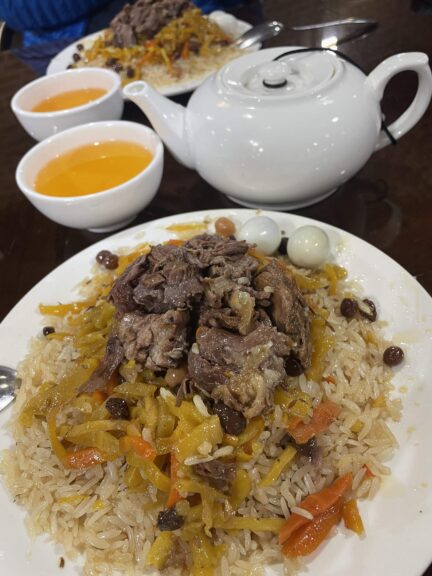
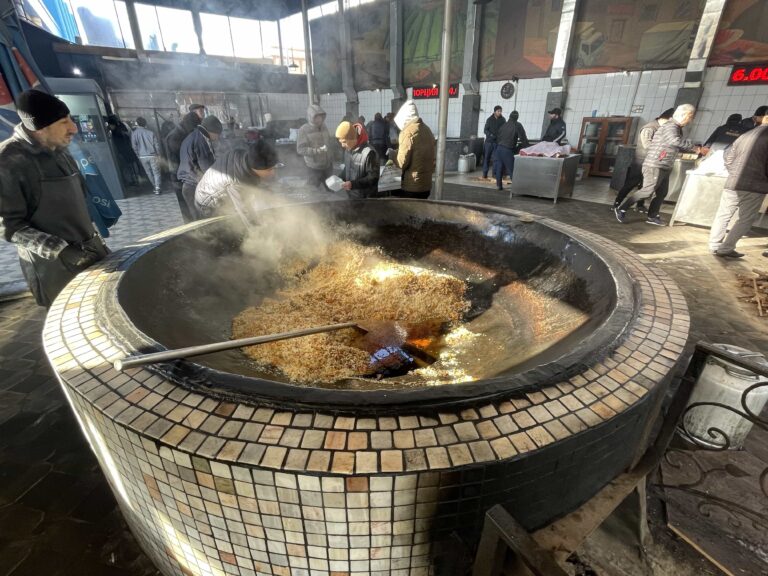
Actually it seems to be the national dish in a lot of places, under different names. Whoever started it, it’s definitely a big deal here.
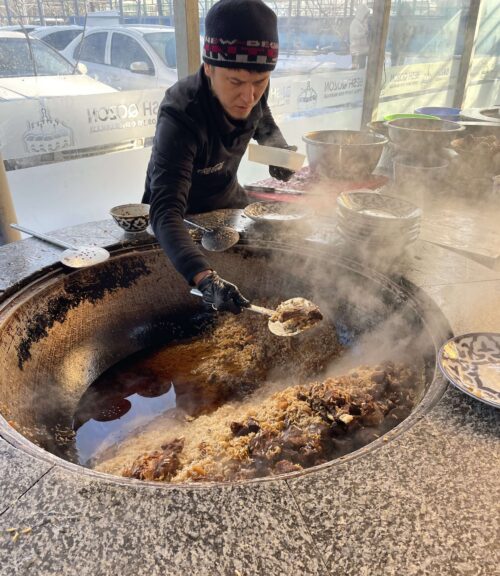
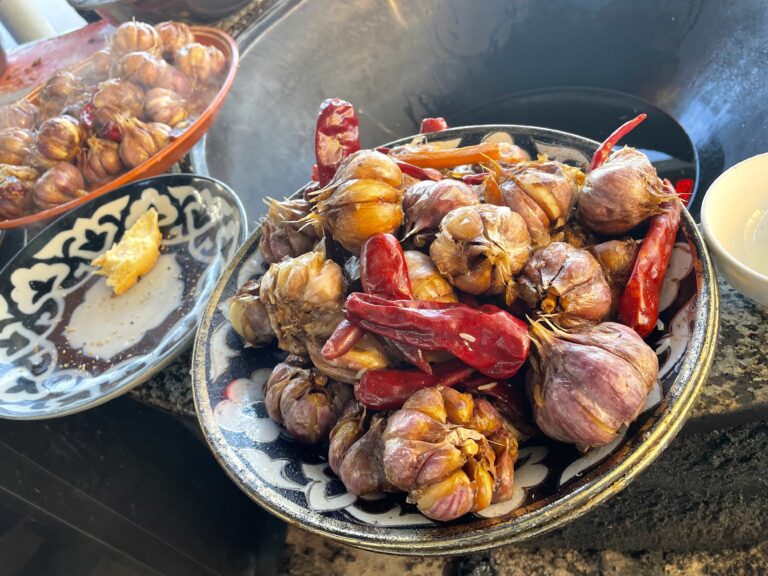
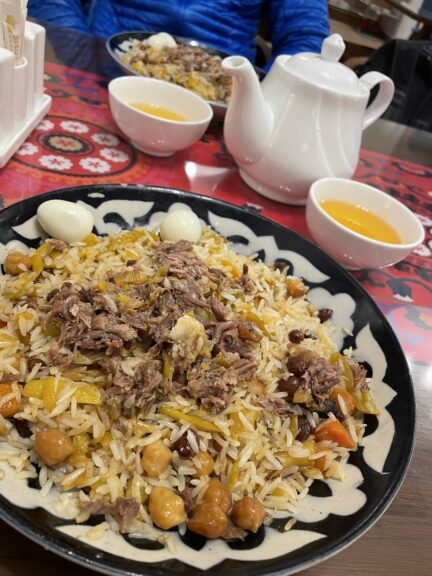
With Pakistan in mind, we assumed we’d end up flying from Tashkent to Islamabad. So we traveled towards Tashkent, stopping in Samarkand for old times’ sake. Having been there done that, we just strolled past the Registan on a morning coffee run without feeling like we had to go in and learn something.
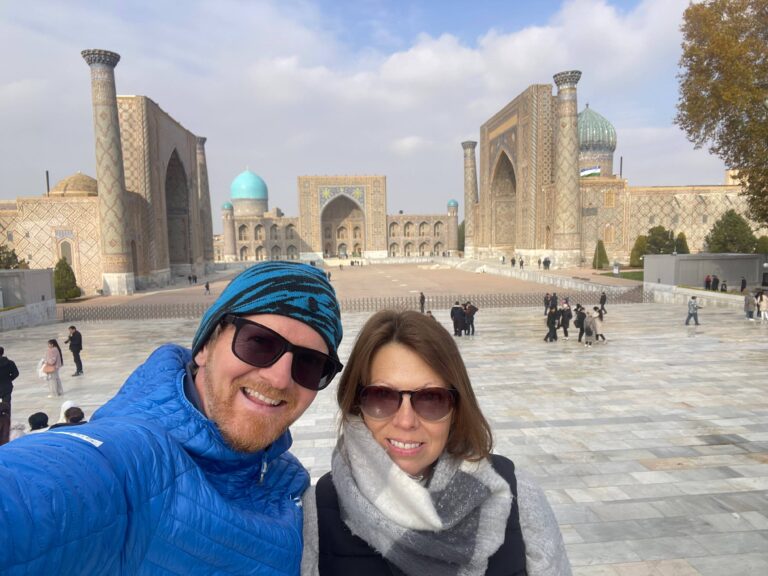
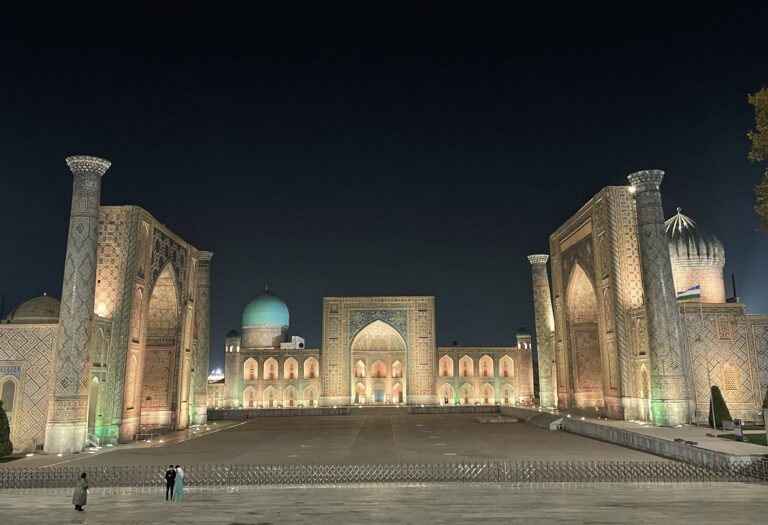
Afghanistan as a realistic destination hadn’t even crossed our minds back home, when we sat around our house poring over maps and fantasizing about this trip. But suddenly there it was, looming large between us and Pakistan. Crossing it by land wasn’t part of the plan when we arrived in Uzbekistan, but now it seemed like the obvious way to go. And we needed to get going. It was December, and getting colder every day.
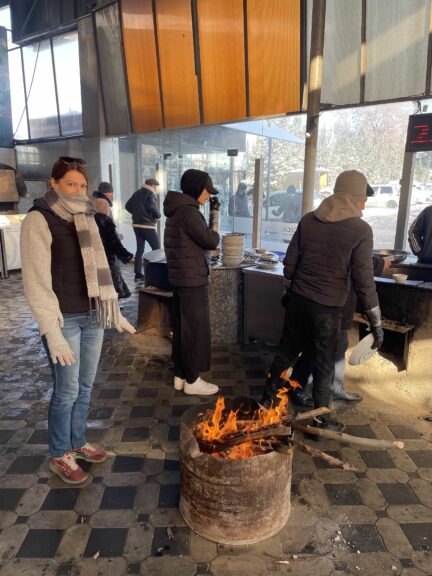
When we woke up to snow on the blue domed mosque next door, that settled it.
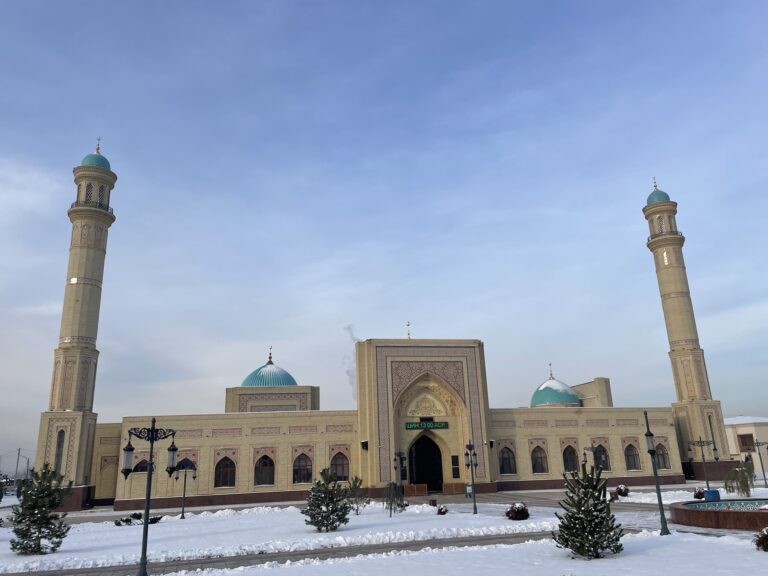
We went to the Afghan Embassy in Tashkent to see if they’d give us a visa or not. The thing is, a lot of Afghan Embassies still belong to the former government, overthrown and replaced by the Taliban in August 2021. Some of them will issue tourist visas, some won’t.
Security’s good, but the border’s closed
The Embassy in Tashkent was dark and deserted. But when the consular officer eventually appeared he shrugged and said sure, he’d give us a visa, in twenty minutes no less. ‘Security is good for foreigners in Afghanistan now’ he explained. ‘But don’t trust anyone. I don’t want you to get kidnapped.’
After that glowing testimonial, we filled out the form. But then the officer volunteered another crucial piece of information: the border between Uzbekistan and Afghanistan is closed to foreign nationals. This threw a wrench in our newly hatched plan. We stared at each other in dismay. Flying to Kabul made no sense at all. One of the major reasons we were going to Afghanistan, besides possible mental illness, was to continue traveling overland to Pakistan.
It wasn’t the first time on this trip where we got stuck and had to fall back behind a border. In fact it’s the fourth time but those are all stories for another post. We’ve always found a way. We knew the Afghan border with Tajikistan was not only open but also issuing visas on arrival, so the solution was obvious to us immediately. We’d just detour into yet another ‘stan and follow the Silk Road into Afghanistan from there.
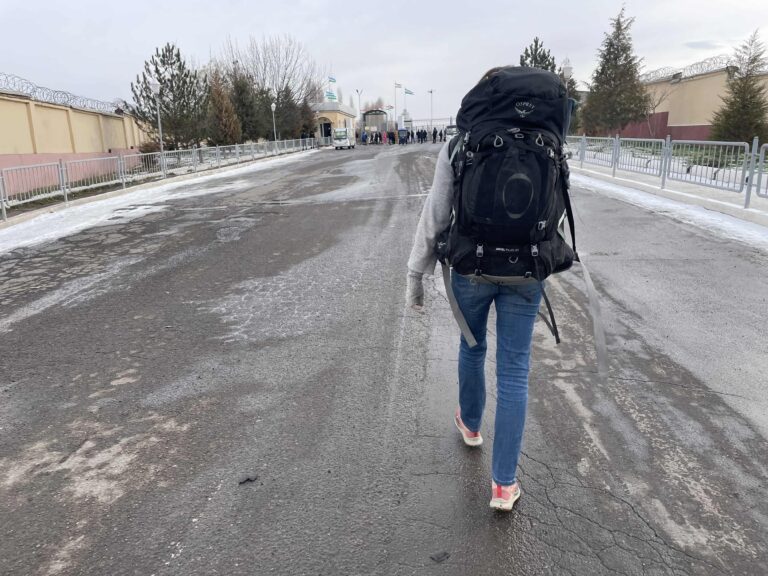
Another ten hours in a share taxi and we reached Tajikistan’s capital, Dushanbe. We’d been here staging a trip once before – our roadtrip on the Pamir Highway. Planning a move from Dushanbe into the unknown – it was déjà vu, times a hundred.
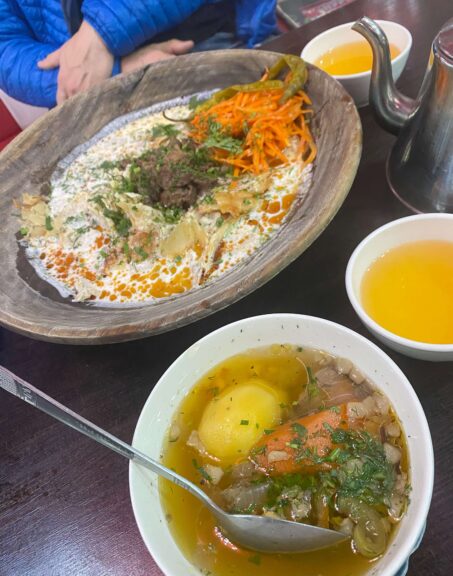
Every cafe in Dushanbe was playing the same five or six Christmas songs in a constant loop. We tried to enjoy the holiday vibe despite hearing ‘I saw Mommy kissing Santa Claus’ several times a day. After all, there’d be no more Christmas once we crossed the border.
There’s no going back from no-man’s land
Early one cold morning, I put on the long sweater/dress I’d bought in the bazaar and we bundled into a taxi with Laurent and Javi, two fellow travelers from France and Spain. Setting off in the semi-darkness for the Tajik-Afghan border, I was nervous despite the reassurance from our host at the guesthouse. He told us that travelers have been coming and going across this very border since the Taliban took Afghanistan over again, just a little more than two years ago.
We stood in a heavy mist outside the last Tajik checkpoint, waiting for a car to run us across no-man’s land. The Tajik guard looked at my hair and made a gesture like pulling up a hood. I put my headscarf on. ‘I heard you shouldn’t look Taliban in the eyes’ said Laurent, and we climbed into the battered taxi. So this was it. We drove slowly through the greyness over the Friendship bridge between Tajikistan and Afghanistan. There was no time to question the wisdom of our decision. I couldn’t think about it anyway, what with ‘I saw Mommy kissing Santa Claus’ still stuck in my head.
Visas on arrival – the Taliban wants tourists
When the Taliban says they’ll give you a Visa on Arrival, it has a different meaning than in say, Indonesia. We spent five hours rambling around a muddy field from one office to another, handing over our passports, filling out forms. A man tapping very slowly on a keyboard pointed at me. ‘I think this is your wife?’ he said to Oyv. ‘Yes she is’ said Oyv, and the man seemed happy. Not just happy – practically overjoyed. It’s a typical reaction, probably stemming from a sense of relief that we don’t just live together. He perused our passports. Then he asked Oyv the question that every person in an official capacity who we were to meet from then on, would ask: ‘Norway. Six months sun, six months dark?’
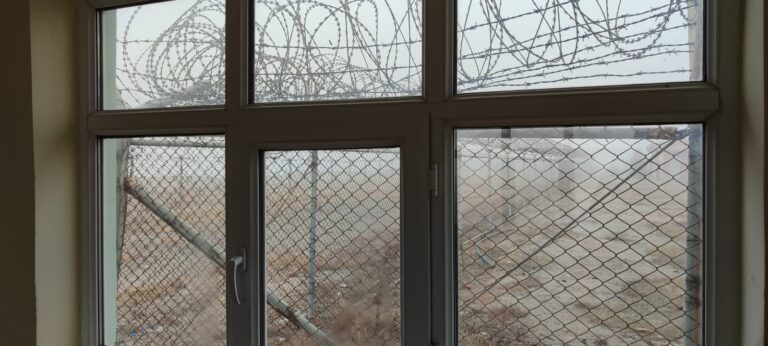
The clutch of offices at the border expands outwards and gradually turns into a small village. Leaving our passports on somebody’s desk, we walked into rural Afghanistan to change some of our USD into Afghanis in the market. Then we carried on to a tiny two room bank where a man dropped his lunch to welcome us, and processed our visa payments.
Walking back, Javi called his brother and put Laurent on the phone. ‘I’m with your brother on the border of Afghanistan’ said Laurent. Javi smacked his forehead and snatched the phone back. ‘I didn’t tell my family!’ he hissed. None of us had, actually. ‘French people should stay in France’ muttered Javi. At the border, we handed over the bank slips and got our passports back, Afghan tourist visas inside.
Does your family know you’re here, Kevin?
It’s only an hour to Kunduz but after all the immigration formalities, we arrived too late to do the next formalities – travel permits – so we just checked into a hotel. ‘Welcome Sir!’ the receptionist exclaimed on sight of Oyv. ‘Who is she?’ he smiled brightly at Oyv. ‘She’s my wife’ said Oyv, and the receptionist looked overjoyed. I could tell I better get used to my new status as invisible, or at best, as Oyv’s wife.
‘I think there’s a ceasefire right now’ said Laurent, on our way out to dinner. I blinked. How had we missed this crucial piece of information about Kunduz being on the brink of total chaos? Then I realized he meant ‘curfew’. But Kunduz is not teetering on the edge of hostilities, and, we were free to go out at least until dark. Anyway, as the hotel receptionist had pointed out, there’s nothing to do. Aside from drawing a lot of stares, and some scarily armed Taliban here and there, nothing seemed unusual about this busy city. Except, you know, whenever I remembered ‘This is Afghanistan’.
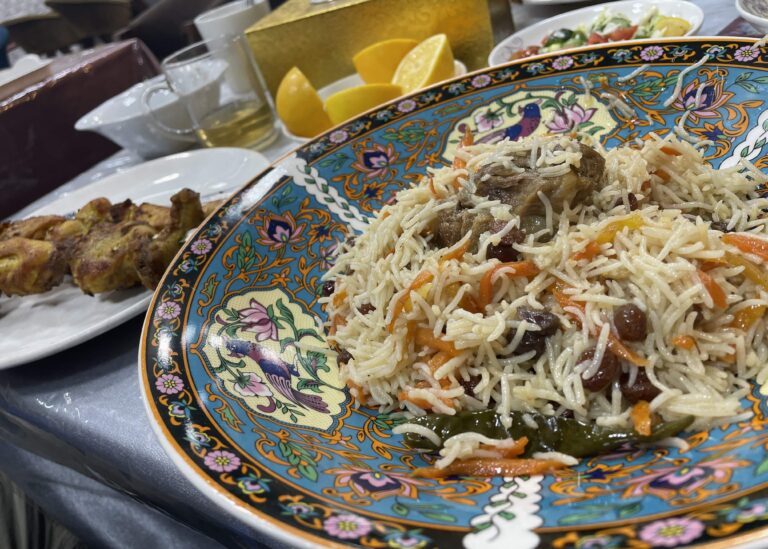
Which is hard to forget, once you’re sitting shoes-off in a carpeted and couch- cluttered office at the Ministry of Culture waiting for somebody to sign off on papers that should probably let you travel between provinces and – maybe? – are necessary to do so. ‘Does your family know you’re here?’ asked one of the many men who all seemed to work at the Ministry. We’d felt that announcing we were off to Afghanistan might put a damper on Christmas spirits back home so we hadn’t told our family, but Oyv nodded yes anyway. Then there was a problem with the Norwegian letters in Oyv’s name. ‘Can we call you Kevin?’ asked the man, and added: ‘You have a beautiful beard.’ They took some group photos and I wondered if Facebook friend requests were next. It was hard to tell if the permits were serious or not.
If these walls could talk
The road to Mazar-i-Sharif isn’t really a road for long stretches. Sometimes it’s just a rutted track in the dirt. Oyv and I had parted ways with our friends and set off in a taxi, banging along for close to five hours past dry brown villages with winding mud-brick walls. For a while we drove through rocky yellow hills that aren’t quite mountains and it looked exactly like the Afghanistan I’d always pictured.
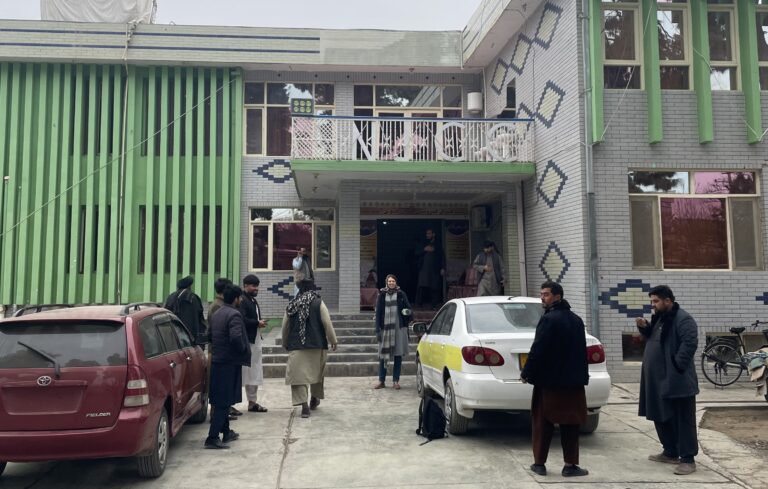
The next day we met up with a guide in our hotel’s empty restaurant. We’d hired Ahmad to show us around Mazar-i-Sharif, and accompany us to the nearby ruins around Old Balkh. Ahmad sat in the front of the taxi wedged tightly between the driver and the Talib we’d suddenly picked up at a checkpoint. He was officially with us for security, but actually just for the ‘tip’ we had to give him afterwards.
Once the capital of the ancient Bactrian region, Balkh’s been here in one form or another for more than 2500 years. The remains of the old city walls, torn down and rebuilt over the centuries, still partially surround the modern town. Balkh has seen a parade of religions, cultures, and conquerors, including Genghis Khan, Timur, and the Mughal Empire.
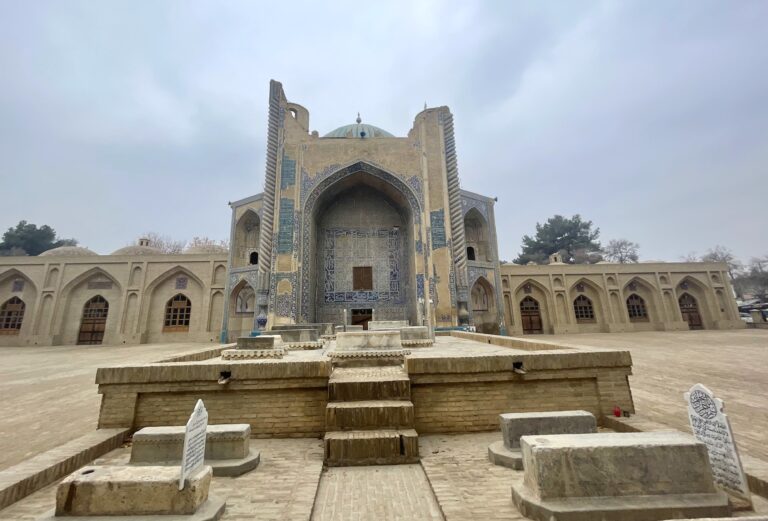
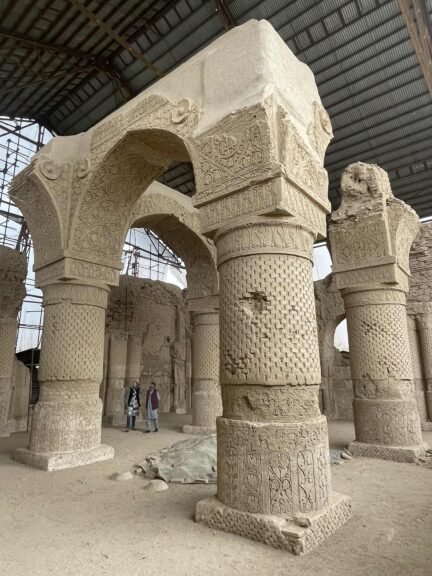
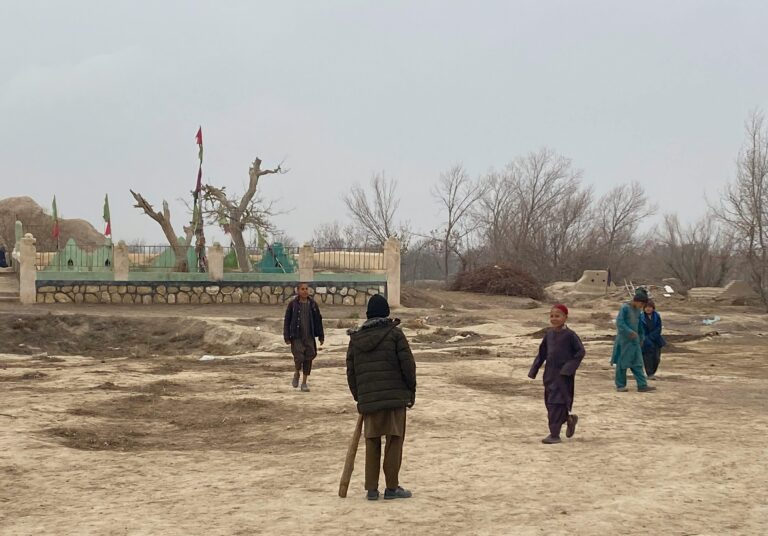
Most recently, these old city walls stood between the Taliban on one side and the Americans and Northern Alliance forces on the other.
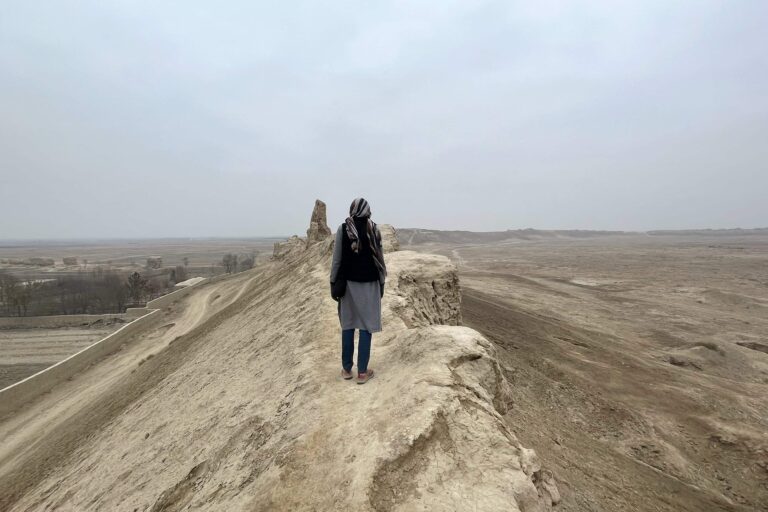
Balkh was a very dangerous place at that time, as the Taliban fought to wrest control of the country from the government. They finally succeeded, in August 2021. We climbed up on the walls and looked around. It felt surreal, just two years later to stand here in relative peace and safety.
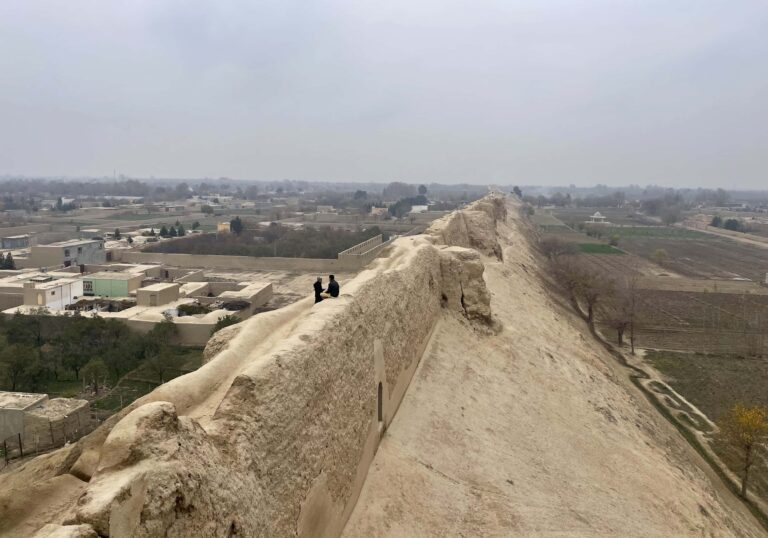
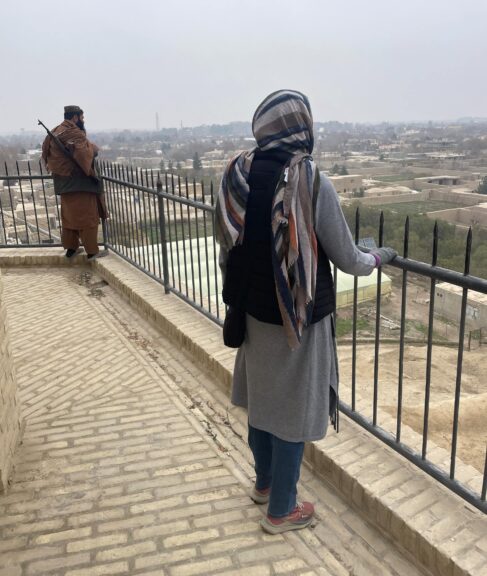
Back in the city we walked to the Blue Mosque, Shrine of Hazrat Ali. Originally built in the 1100s, the shrine was pulled down by Genghis Khan when he razed Balkh around 1220. It was rebuilt in the 1400s but the stunning blue tiling is from the 19th century.
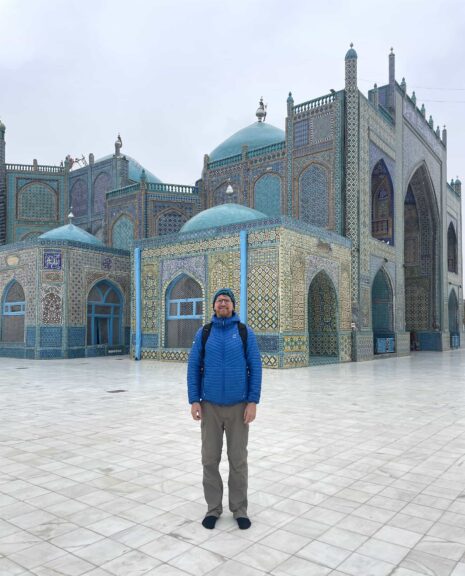
Local legend says the shrine houses the tomb of Ali, cousin and son-in-law of the Prophet Mohammed. Or does it? While some Sufi Sunni Muslims consider this to be the site of Ali’s grave, many Shia Muslims believe the true site is in Najaf, Iraq.
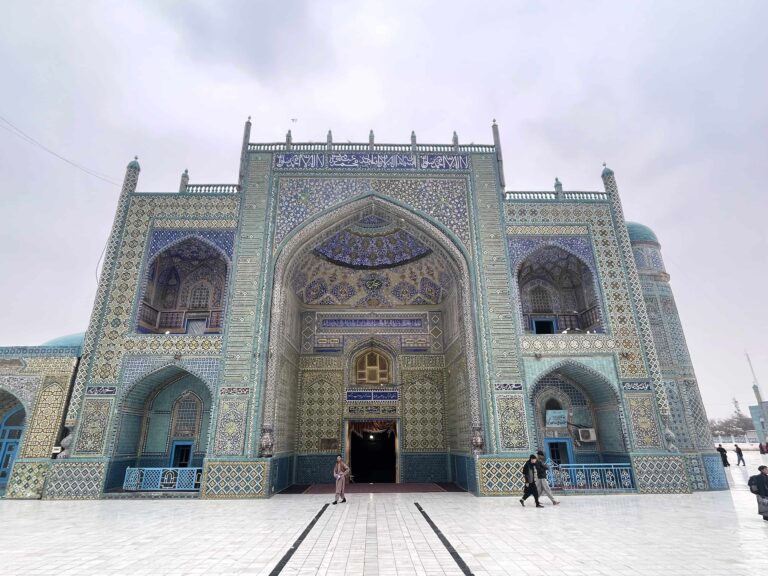
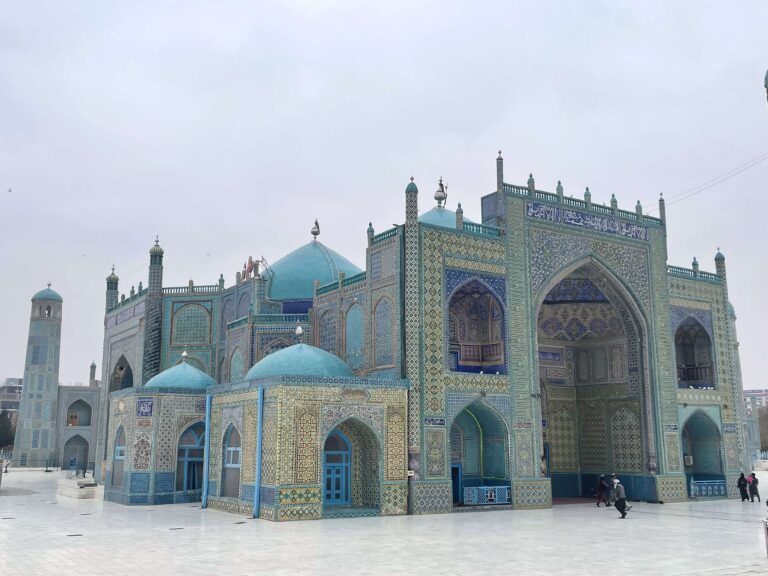
As a foreign woman I’m not allowed into the Blue Mosque, not even past the gates. Ahmad shook his head sadly when I asked if this was always the rule. ‘Under the previous government…no problem. ‘ he said.
There are varying strange and horrible restrictions on Afghan women. One is that they aren’t allowed into public parks, so a family afternoon enjoying the a green space is restricted to their husbands and children only. Probably worst of all, is that girls are no longer allowed to attend school past the sixth grade. A father of two young daughters, Ahmad looked distraught when we asked about it. ‘Under the previous government….no problem’. His worries don’t stop there, either. Unemployment is soaring and no foreign business will invest in Afghanistan. ‘Because of….you know why’ he said, shaking his head and zipping his finger across his lips.
Getting comfortable in Kabul
It’s hard to find the permit office in Kabul. In our efforts to locate it we went by accident to both the FDA and the Ministry for Business and Intellectual Property Patents. When we did find it, we walked through a zigzag maze of concrete barriers laced with razor wire to get into the compound.
Starting with the consular officer back in Dushanbe and right up to the day we left Afghanistan, we heard one constant refrain: ‘Security is good now. It’s safe here, for foreigners too. No problem!’. It felt safe enough to us. I’d stopped listening for suspicious noises from the street at night. After breakfast one morning I watched as the hotel security guard opened a flimsy cabinet to reveal a second huge gun like the one he was already carrying. He handed it to another security guard in a bulletproof vest and the two of them stood there in the lobby for a while. We just ducked through the metal detector and went out for the day. It’s true that the suicide bombings and terror attacks which once happened on a regular basis are pretty rare now. Opinions about the Taliban are both strong and divided. It depends how you feel about achieving relative safety via serious weaponry and rigid control, and the Taliban have a lot of both.
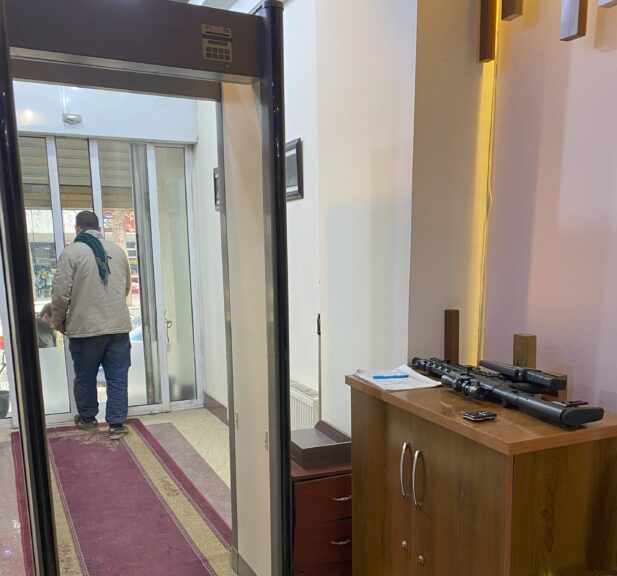
Either way, nobody batted an eye at us wandering around the streets of Kabul.
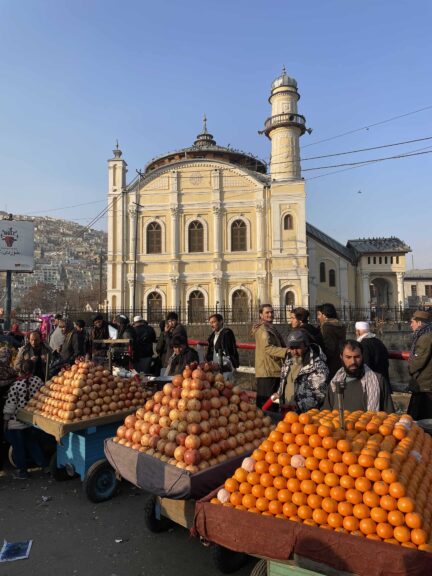
We walked up Television Hill to the Sakhi Shrine.
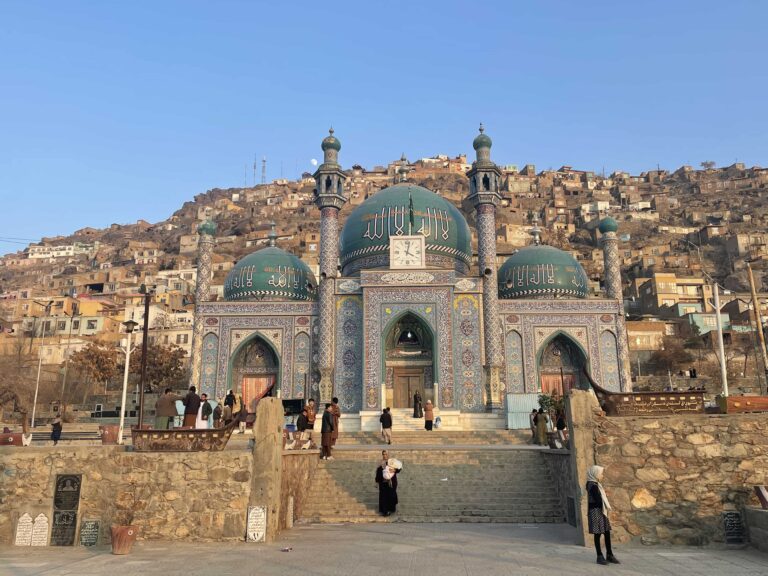
According to legend, in the 12th century some men were traveling with the Prophet’s cloak. They stopped here to rest along the way (it wasn’t called Television Hill at the time). They were visited by an apparition of Ali praying next to the cloak, his sword resting on a rock nearby. The shrine went up over the rock and stands there to this day, although the cloak was moved to Kandahar after eight months or so.
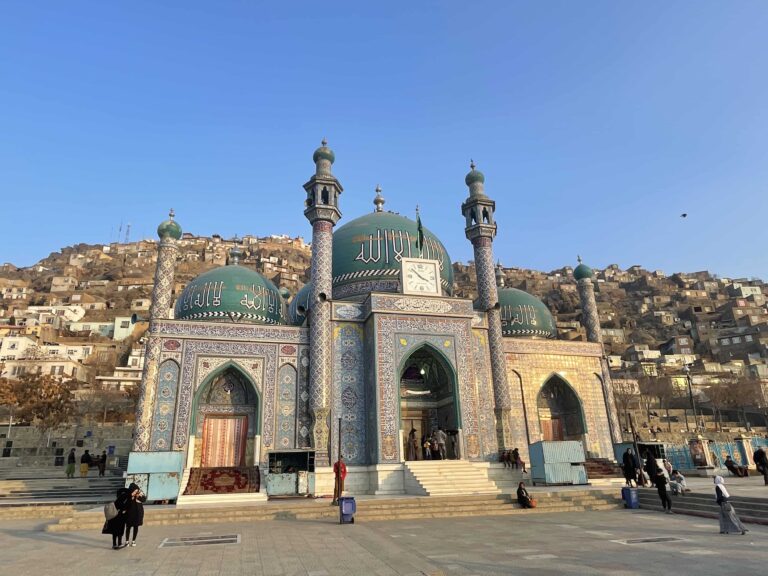
‘Take me with you to your country!’ said the woman who searched me in a tent outside and adjusted my headscarf. The shrine is mostly visited by Shia Muslims and has seen a number of significant attacks – security is predictably tight. After checking if we’re married and that it’s dark for six months a year in Norway, the Taliban soldiers at the gate waved us in.
The sun shone on the houses running down the steep hillsides surrounding the shrine. There were families here, with kids running around on a day out. Some girls took selfies with me. Oyv told some men who asked if he was a Muslim that he was a Christian. He’s not, but anything’s better than an atheist. They laughed, and asked if he wanted to convert.
We went to Bagh-e Babur, a recreational garden that’s off-limits to local women. Babur, the first Mughal Emperor, established the park in the early 1500s and was later buried in it.
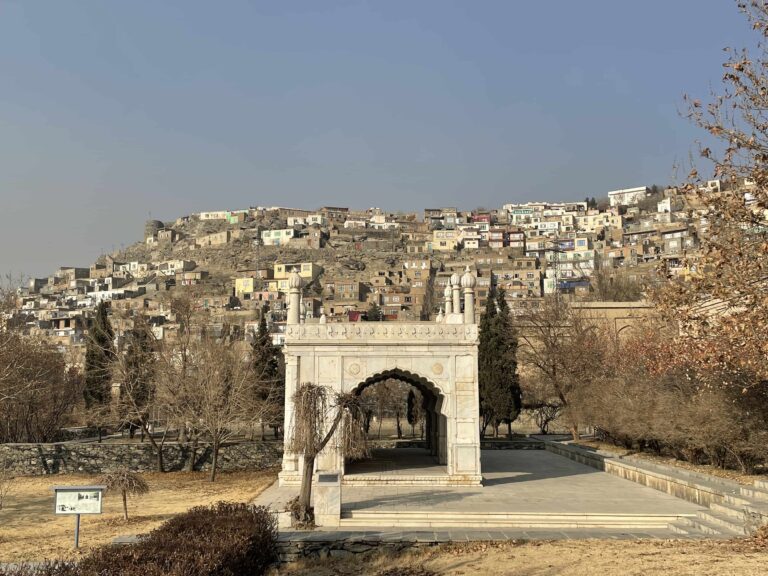
The garden/tomb concept really caught on. Babur’s successors planted gardens like these all over Pakistan, Bangladesh, and India.
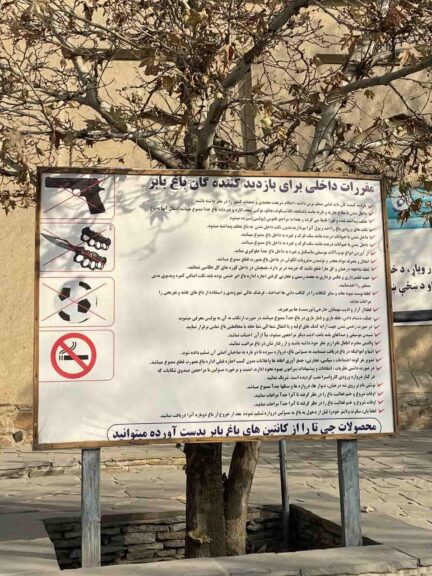
Then there’s the Bird Market and Chicken Street, not to be confused. The Bird Market does sell birds – including chickens – for decoration, for eating, and for fighting.
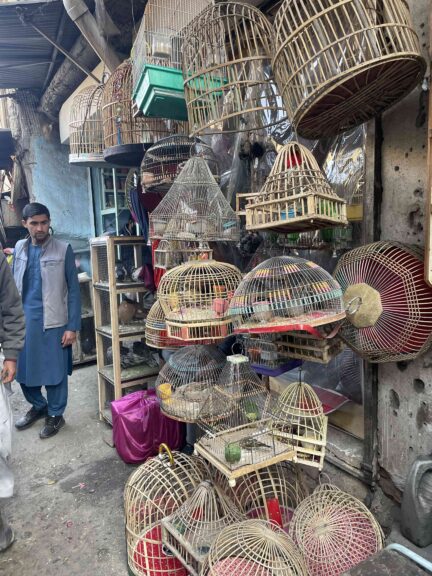
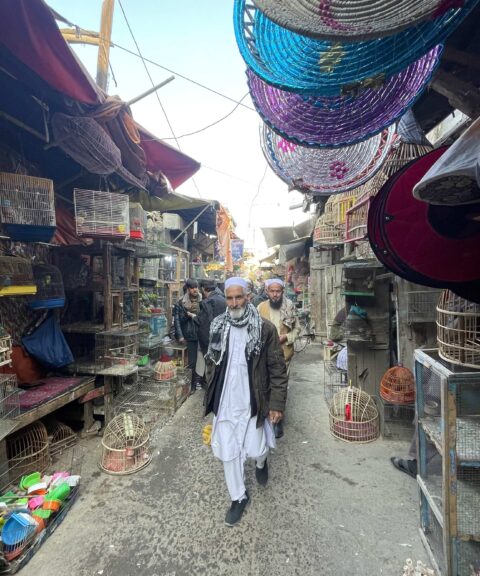
Chicken Street has nothing to do with poultry. It’s a shopping street for souvenirs like carpets and teapots. Hash and opium were the most popular (and more portable) souvenirs in the 60s-70s when Afghanistan was just another stop on the hippie trail to Kathmandu.
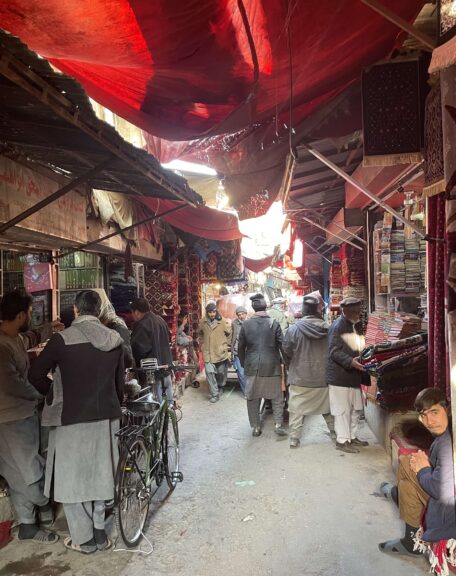
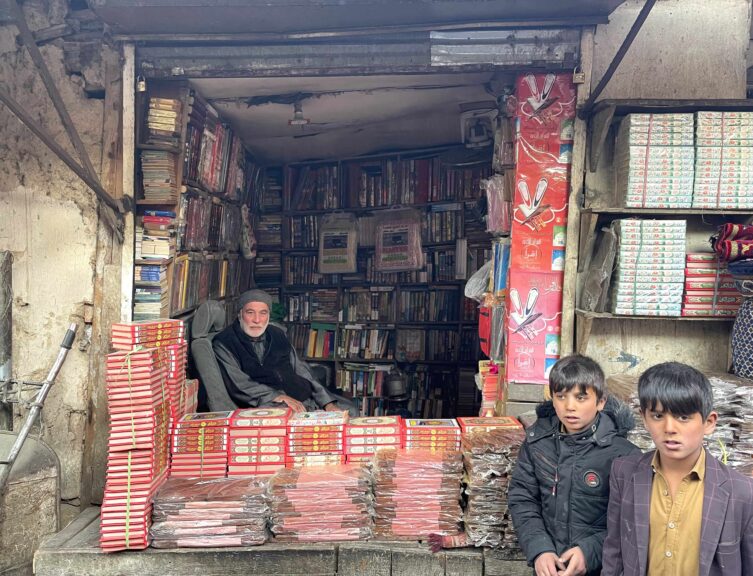
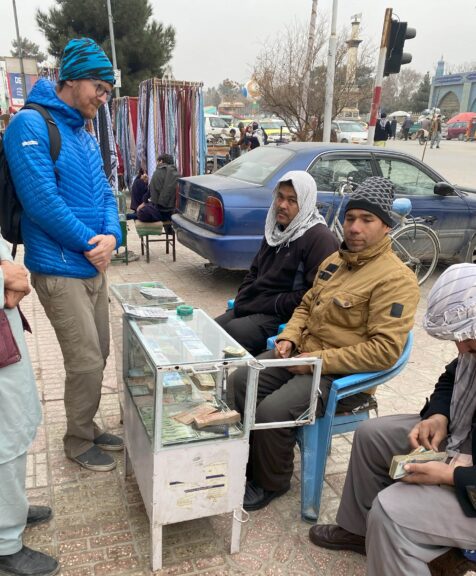
We weren’t shopping for anything. Certainly not birds or carpets or drugs, nor books either – but we still went looking for the bookstore from the novel Bookseller of Kabul. We were too late though. The bookstore shut down recently and its owner is currently a refugee in the UK.
Christmas 2023 – Afghanistan
Another share-taxi through the mountains and we reached Jalalabad.
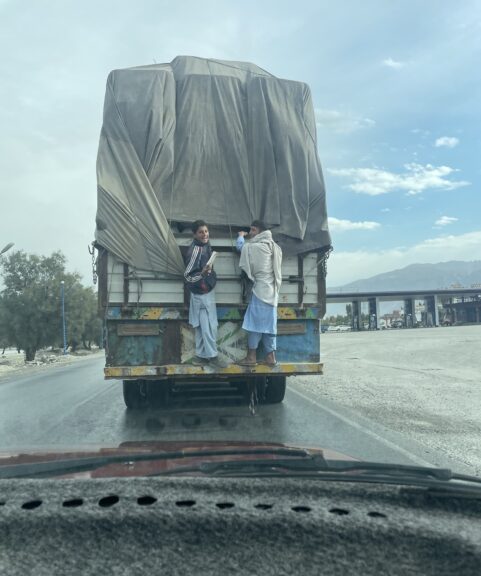
Checking into a vast and drafty hotel room, we asked the receptionist if it was safe to walk around town at night. ‘Oh yes’ he answered. ‘Its very safe, day and night. The Taliban is very good for us.’
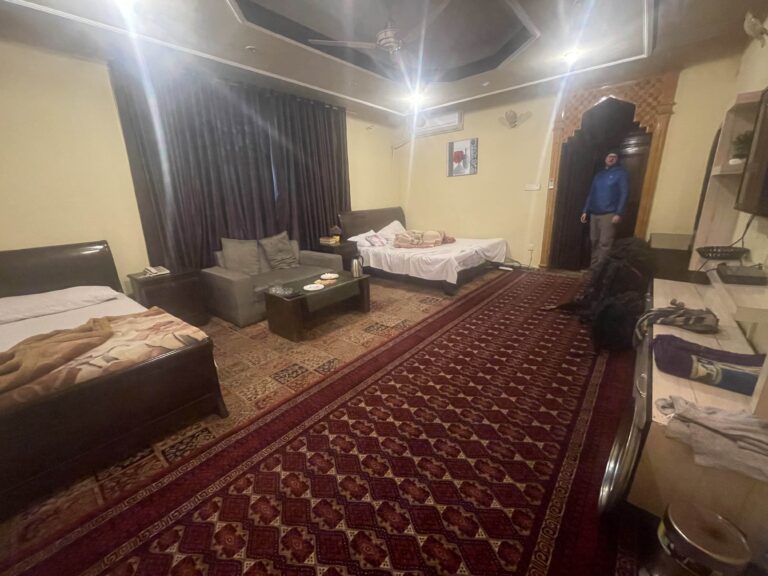
Jalalabad is a friendly place. We walked around, so we met a lot of people, sampled the street food, and drank tea in a carpet shop.
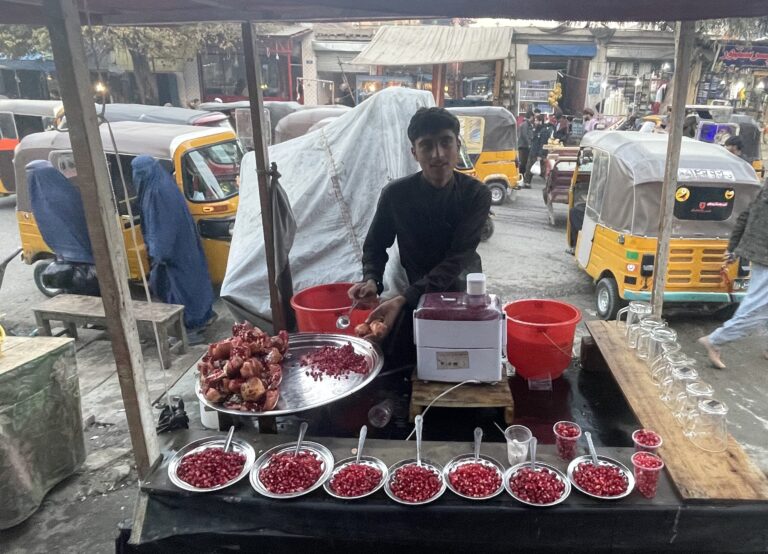
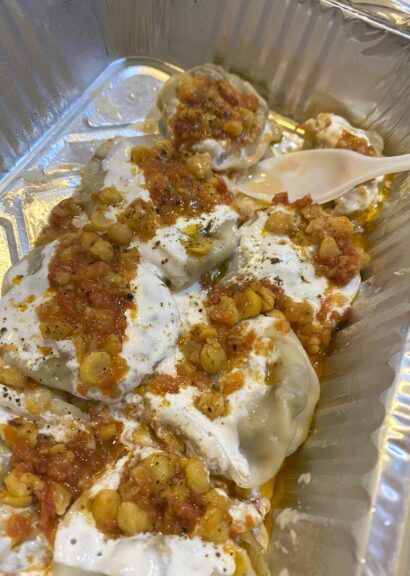
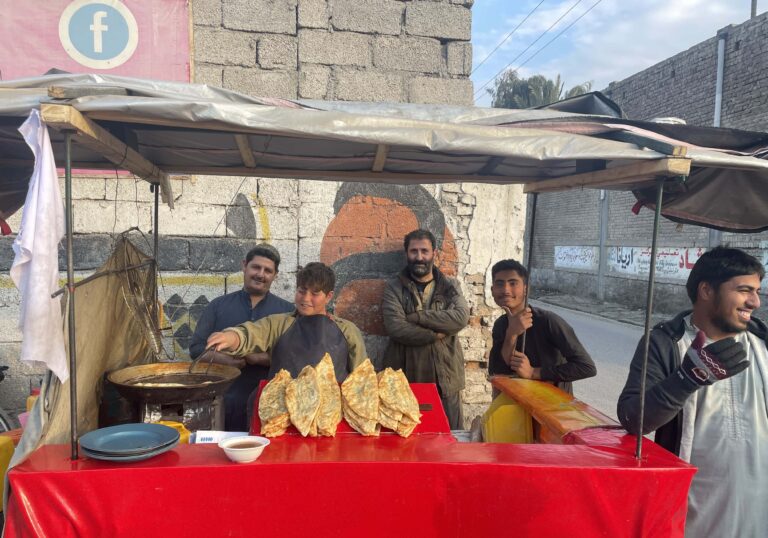
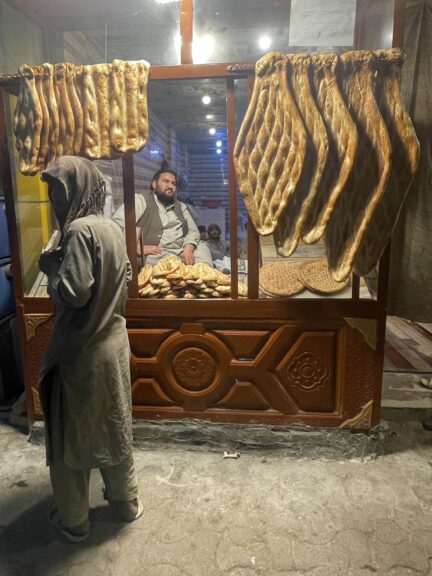
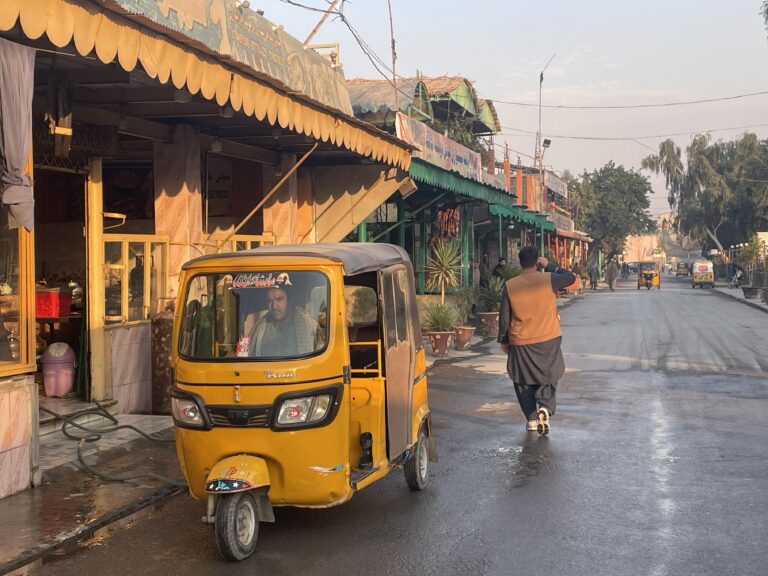
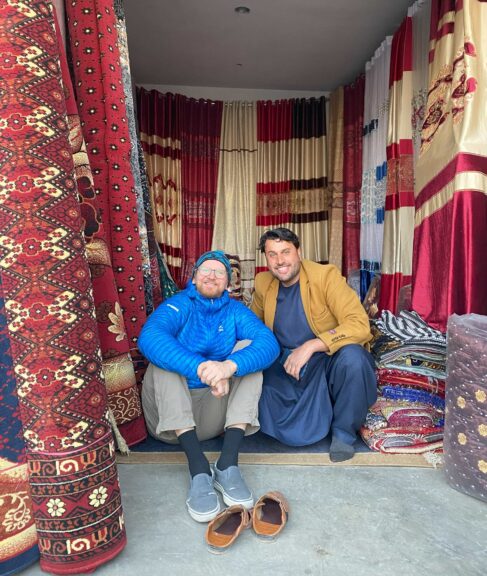
And we went out for Christmas dinner. We weren’t celebrating, we just called it that since it was a dinner, anyway. I was totally fine with not hearing ‘I saw Mommy Kissing Santa Claus’. We had a lot of big feelings about traveling through Afghanistan. And we’re really glad we did. After all, one of the best things about overland travel is the option to suddenly swerve, and take the road less traveled.
Read More
For more of our adventures (and misadventures) as we travel from Cameroon to Japan, check out the rest of my stories from the road.
Thinking about traveling from Afghanistan to Pakistan by road, yourself? I’ve written two posts about crossing the borders we used to get in and out:
How to cross the Shir Khan border from Tajikistan to Afghanistan
How to cross the Torkham border from Afghanistan to Pakistan
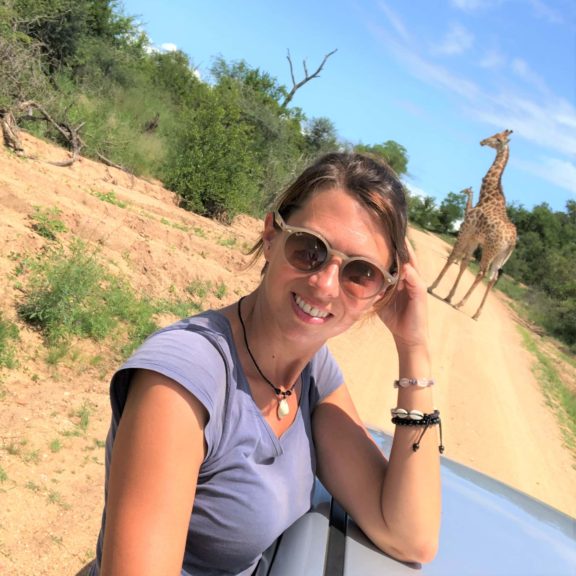
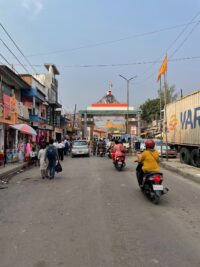
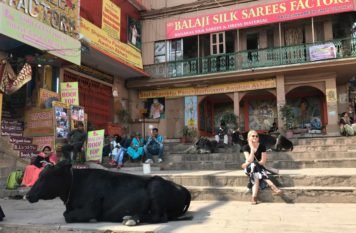
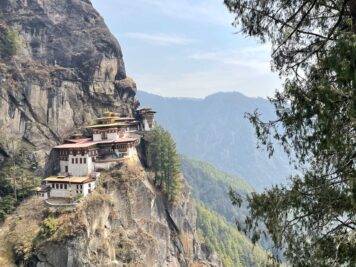
This Post Has 6 Comments
Great read, thank you for sharing.
Thanks! (and happy to:))
Terrific! Photos are really good. It would be helpful to include a map of your route. I’m reading more and more blog posts and stories of independent travelers passing through Afghanistan; I can’t say I’m a fan of the Taliban but it’s hard to deny it’s brought security — at least for now. Well done!
Thanks! Yes, that’s it…things could change at any time.
Wow so cool!! I came across your article since i want to cross the same border. I’m traveling solo as a 27 year old guy from the Netherlands (dark hair, slightly tan, 2,04m tall). You think it will be safe enough for me to travel alone without a guide from the border to Kabul – Mazar i Sharif – and exiting Afghanistan to Uzbekistan? And what about public transport between these places? Looking forward to your answer!
Steef
Hi! Thanks:) Yeah – it was a great trip, for sure. About safety – it felt ok and ‘safe enough’ to us. But that’s something you’d have to think about carefully for yourself – depends on what you’re comfortable with, I guess. Keep in mind this is the sort of place where things change all the time, so you’d want to be really up-to-date on the current situation whenever you go. Staying at Green House Hostel in Dushanbe before we left was handy for us – other travelers come and go that way so we could ask around a bit. We used public transportation and didn’t find that it was any different or more difficult than anywhere else in the region (if you’re familiar with share-taxis etc already). We didn’t have any issues at checkpoints. At the time we were there the road from Mazar to Kabul was under construction so there’s that sort of thing, plus weather, to think about. I just posted two more guides on here about the border crossings we used from Tajikistan and to Pakistan, so you can have a look. And, one more thing: in December 2023, the border crossing to/from Uzbekistan was closed to foreigners. That’s why we went from Tajikistan. That might change though. Hope that helps!